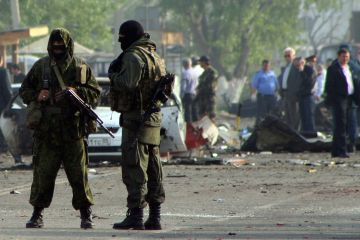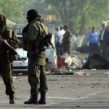
Skewed Government Data on Attacks Creates False Picture of Stability in the North Caucasus
Publication: Eurasia Daily Monitor Volume: 11 Issue: 24
By:

Since the start of the year, the conflicting sides in the North Caucasus and media monitoring organizations have begun providing figures for the number of people killed and wounded in fighting between government forces and militants in 2013.
Losses in the conflict between the Caucasus Emirate armed underground movement and the Russian government in the North Caucasus have actually been declining over the past several years. In 2013, the number of victims of the armed conflict in the North Caucasus fell by 239, or 19.5 percent. Both the number killed and the number wounded plummeted: 529 people were killed in 2013—24.4 percent less than in 2012, when 700 people died—while 457 were wounded in 2013 compared to 525 in 2012, which was a 13 percent drop. However, against the backdrop of a general decrease in the number of casualties, the number of civilian casualties increased (https://www.kavkaz-uzel.ru/articles/237362/).
The rise in the number of civilian victims was due to higher losses in Dagestan: 14 civilians died in police special operations, 16 civilians died in terrorist attacks and 74 civilians died in attacks and shootouts by unidentified actors or were kidnapped and killed. The civilians killed by the North Caucasian armed underground in ethnic Russian regions were not included in the figures. If the victims of the attacks in Volgograd are added to the data from the North Caucasus, then the number of people killed in 2013 is 572 and the number of wounded is 577—a total of 1149 casualties. Thus, the overall decrease in losses in 2013 in comparison to 2012 would be 19 percent.
While the number of civilian losses increased, the losses among the rebels decreased by 26 percent. This, however, is by no means an achievement on the part of the militants. The decrease reflects a decline in the level of insurgent activity in Chechnya and Ingushetia in comparison to Dagestan and Kabardino-Balkaria, which remain tense. Throughout 2013 Russian security forces carried out successful special operations against militants across the entire North Caucasus, particularly in Dagestan and Kabardino-Balkaria (https://warsonline.info/severniy-kavkaz/bolee-260-boevikov-unichtozheno-v-2013-godu-na-severnom-kavkaze.html).
In the first nine months of 2013, 200 militants were killed, while in the last three months of the year, another 98 suspected militants were eliminated (https://ria.ru/crime/20131128/980428708.html). In the same period, according to Andrey Medvedev, the deputy head of the Prosecutor General’s office in the North Caucasus, the number of extremist crimes in the North Caucasian Federal District rose by 40 percent (https://itar-tass.com/proisshestviya/837960).
Not surprisingly, the armed opposition has released different figures for last year. According to sources close to the rebels, 915 government servicemen were casualties, 341 of whom were killed and 574 wounded. Overall, the militants claim to have carried out 412 operations and lost 117 people, including three rebels who were captured. These estimates are given according to the Islamic calendar and thus cover the period from November 2012 to November 2013 (https://ummanews.com/news/last-news/11927———-1434—.html).
At the same time, the figures coming from Russian government sources about the North Caucasus should be treated with a certain degree of skepticism and the same applies to the militants via their websites—as each side is incentivized to provide numbers that show their successes. A prime example of this is the suicide bombing attack in Sernovodsk, Chechnya, last September 16, that killed three Chechen police officers and wounded five (https://www.vesti.ru/doc.html?id=1130293), which was not reported in the Chechen interior minister’s final report for 2013 (https://www.grozny-inform.ru/main.mhtml?Part=11&PubID=48700).
Violent acts are reclassified as mere criminal actions in order to avoid listing them as terrorist attacks. If the authorities adopt such methods for dealing with terrorist attack statistics, then even the attack in Volgograd, which claimed dozens of lives, could be called just another criminal act and lower the terrorist threat on paper. These varying accounts are confusing to the public, as it is hard to explain why the number of rebel activities has decreased while the situation in the region has not calmed down.
Terrorism, in fact, is on the rise, but data manipulation artificially creates a false picture of peace in the region. Regional militants are rethinking their tactics and redirecting their activities to areas outside of the North Caucasus. The situation is beginning to resemble a larger scale version of what happened in Chechnya in 2001–2002, when the top commanders of the Chechen resistance decided to take war outside the republic after a suspension of attacks in Russia in response to the protest movement in Moscow. The move by militants to attack cities outside their normal territory was designed to make Russian forces spread out across the other nearby republics—Ingushetia, Dagestan, Kabardino-Balkaria and Karachaevo-Cherkessia. Today, the rebels have expanded their activities beyond the North Caucasus to the Volga region and areas adjacent to the North Caucasus (https://rushor.com/articles/2795). It is hard otherwise to explain how the number of losses is going down while the situation in the region is becoming increasingly radicalized.
The situation for Moscow is further aggravated by the involvement of North Caucasians in the Syrian conflict, where they are occupying leading positions in radical organizations (https://www.jamestown.org/single/article_id=41861&no_cache=1#.Uu4cRBR5N8E). The merger of Chechens into the radical Middle Eastern groups is a particularly bad omen for Russia. These contacts will strengthen the ties between North Caucasian and Middle Eastern jihadis.
Analyst Semyon Bagdasarov believes the situation is becoming increasingly radicalized. “The reason for that is the active work of Islamic organizations, including terrorist ones, in influencing Russians returning from Syria. For the fight against extremism, what is needed besides special operation is serious ideological work by specialists. Otherwise, it can be predicted that terrorism will take off” (https://www.aif.ru/dontknows/answer/1037645).
Thus, the statistics for 2013 provide little reason to be optimistic about 2014. On the contrary, the situation will deteriorate under the influence of external forces, and the processes of radicalization in the North Caucasus as well as the expansion of radicalism to neighboring regions will likely intensify.




